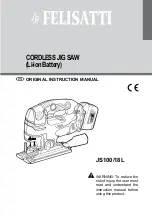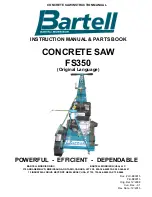
10
42.
Support long workpieces with appropriate
additional supports.
43.
Never cut so small workpiece which cannot
be securely held by the vise.
Improperly held
workpiece may cause kickback and serious
personal injury.
44.
Do not use the saw to cut other than wood,
aluminum or similar materials.
45.
Make sure that the turn base is properly
secured so it will not move during operation.
46.
Make sure the blade does not contact the turn
base in the lowest position and is not
contacting the workpiece before the switch is
turned on.
47.
Hold the handle firmly. Be aware that the saw
moves up or down slightly during start-up and
stopping.
WHEN USING IN THE TABLE SAW (BENCH SAW)
MODE:
48.
Make sure that the arm is securely fixed in the
working position. Tighten the lever clockwise
to fix the arm.
49.
Make sure that the bench saw table is
securely fixed at the chosen height.
50.
Do not perform any operation freehand.
Freehand means using your hands to support
or guide the workpiece, in lieu of a rip fence.
51.
Make sure the blade is not contacting the
riving knife or workpiece before the switch is
turned on.
52.
Pay particular attention to instructions for
reducing risk of KICKBACK. KICKBACK is a
sudden reaction to a pinched, bound or
misaligned saw blade. KICKBACK causes the
ejection of the workpiece from the tool back
towards the operator. KICKBACKS CAN LEAD
TO SERIOUS PERSONAL INJURY. Avoid
KICKBACKS by keeping the blade sharp, by
keeping the rip fence parallel to the blade, by
keeping the riving knife and blade guard in
place and operating properly, by not releasing
the workpiece until you have pushed it all the
way past the blade, and by not ripping a
workpiece that is twisted or warped or does
not have a straight edge to guide along the
fence.
53.
Avoid abrupt, fast feeding. Feed as slowly as
possible when cutting hard workpieces. Do
not bend or twist workpiece while feeding. If
you stall or jam the blade in the workpiece,
turn the tool off immediately. Unplug the tool.
Then clear the jam.
SAVE THESE INSTRUCTIONS.
WARNING:
DO NOT let comfort or familiarity with product
(gained from repeated use) replace strict adherence
to safety rules for the subject product. MISUSE or
failure to follow the safety rules stated in this
instruction manual may cause serious personal
injury.
INSTALLATION
CAUTION:
Keep the floor area around the tool level well
maintained and free of loose materials such as chips
and cut-offs.
Installing auxiliary plate
Fig.1
Fig.2
Always install the auxiliary plate using the notch in the
tool's base and secure it by tightening the hex bolt
before operation.
For European countries
Installing the holders
Fig.3
Fig.4
Install the holders on both sides of the base and secure
them with screws.
Adjust the adjusters so that they contact the floor
surface.
Bench mounting
This tool should be bolted with two bolts to a level and
stable surface using the bolt holes provided in the tool's
base. This will help prevent tipping and possible injury.
Fig.5











































